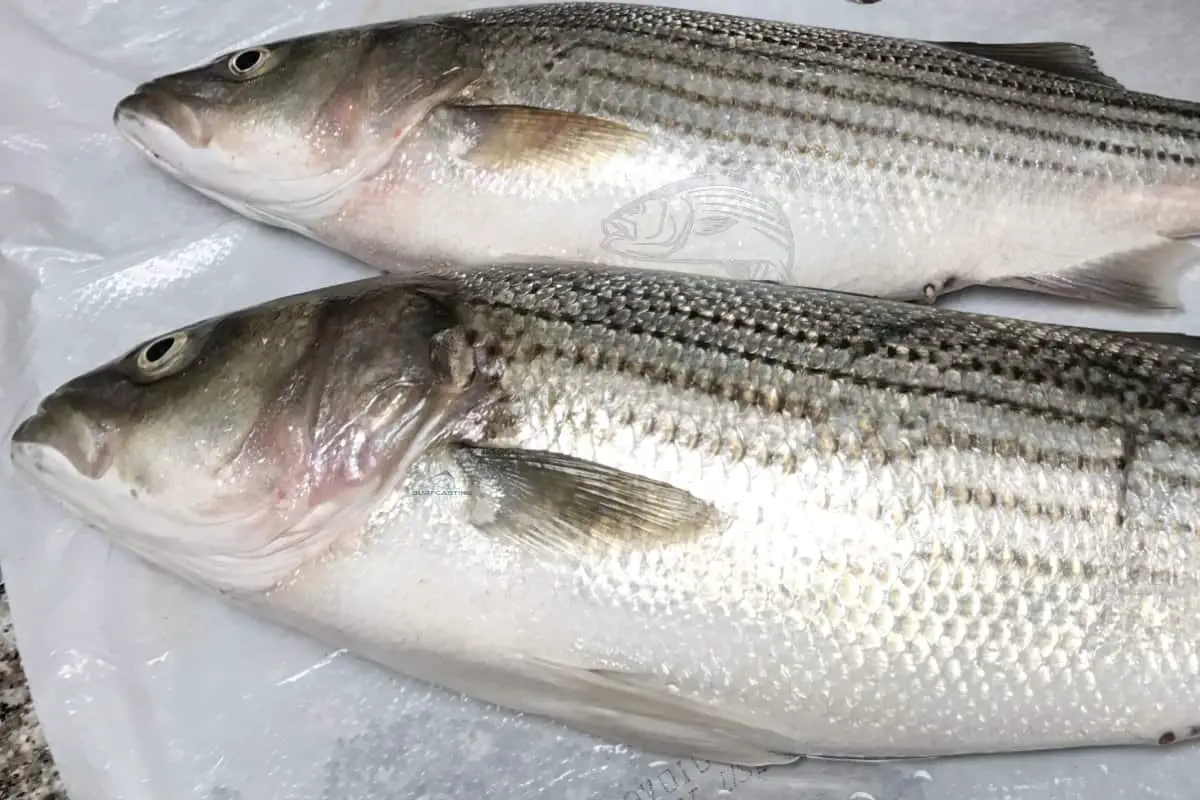Not every bass with stripes is a Striped Bass. A Hybrid Striped Bass — sometimes called Whiterock, sunshine, or palmetto bass — is a cross between Morone saxatilis (striped bass) and Morone chrysops (white bass).
The hybrid fish was developed for aquaculture in the United States in the 80s. Hybrid Striped Bass are both food fish and game fish.
Each of the striped bass, white bass, and hybrid striped bass are subject to different size limits, seasons, and creel limits.
For this reason — and just because you should know your bass — what is the difference between striped bass and hybrid striped bass?
Striped bass has distinct stripes that extend to the tail. They have slender bodies with a width of less than one-third its length. Hybrid striped bass‘ stripes are distinct but usually broken and intermittent. They have deeper bodies with a height that is more than one-third the length of the fish.
What Are The Differences Between Striped bass, Hybrid Striped bass And White Bass?
Understanding and recognizing the features of a hybrid striped bass is a bit easier with knowledge of the two fish that are crossed to produce the hybrid: the striped bass; and the white bass.
Striped bass
Striped bass usually weighs five to ten pounds (although 15 to 20-pound striped bass are not uncommon in Pennsylvania) and have a smoothly arched and slim profile.
Striped bass that lives at sea grows much bigger, to weights of 100 pounds or more.
A striped bass’ back ranges from olive-green to steely blue-gray, and the fish has silver to silvery-green sides that can shade to a white belly. The name makes sense.
A mature striped bass features as many as eight sharply defined stripes that run the fish’s length on the sides of its body.
Young striped bass doesn’t have those dark stripes but has dusky and less distinct bars.
Striped bass has two dorsal fins: a spiny-rayed front fin; and a soft-rayed fin that might be broken by a notch. A striped bass’ anal fin has three spines and 11 soft rays.
The longest spine is not half the height of the anal fin. Unlike white bass, striped bass has two tooth patches at the back of their tongue.
White bass
White bass is silvery, medium-sized fish that has an arched back. They range from 18 to 20 inches long at maturity and weigh up to three pounds (but more commonly weigh between half-a-pound and two pounds).
White bass has a deep body with a blue-gray or steel-gray back with sides ranging from silvery-white to silvery-green and a yellow tinge along the lower edge.
White bass’ markings consist of between four and seven gray-brown or even black stripes that are less distinct than those on striped bass.
Both dorsal fins have a separating notch; the anal fin is made up of three spines and 12 or 13 soft rays. Both dorsal and caudal fins are clear or tending to gray.
A white bass’ mouth has a patch of teeth on the tongue’s base. The fish’s bottom jaw extends beyond the length of its upper jaw.
Hybrid striped bass
A hybrid striped bass has a body that is much thicker and stockier-looking than a pure striped bass.
The stripes on the hybrid striped bass are not continuous along the body’s length but interrupted, broken, and less distinct.
There may be as many as seven or eight of those faint and broken lateral stripes on the silvery sides of a hybrid striped bass.
The hybrid’s back is nearly black, and its belly white. The hybrid’s anal fin has either 11 or a dozen rays.
As for the size of a hybrid striped bass, it’s truly a cross between the striped bass and the white bass and will grow to a length and weight between them — up to something in the range of 10 to 12 pounds.
There are a few rules of thumb for keeping them all apart:
- white bass are fat; striped bass are slender; striped bass have strong horizontal stripes;
- white bass have more faded stripes; hybrid striped bass are shorter than striped bass but not as deep as white bass;
- hybrid striped bass has broken and patchy horizontal stripes.
How is the Hybrid Striped bass Produced?
The first hybrid striped bass was developed in South Carolina in the 1960s. That might explain their original nickname — Palmetto bass — since the South Carolina flag features a palmetto tree.
Those first generations of Palmetto bass (now hybrid striped bass) came from mixing a female saltwater striped bass’ eggs with the sperm from a male freshwater white bass.
A more recent reverse hybridization (consisting of eggs from a freshwater female white bass and sperm from a saltwater male striped bass) produces a hybrid striped bass sometimes nicknamed the Sunshine or Cherokee bass.
Are Hybrid Striped bass Popular Gamefish?
Hybrid striped bass has reputations for being aggressive feeders. That makes them desirable gamefish amongst anglers.
Stocked hybrid striped bass feed on shad and other baitfish by breaking the surface in schools of thousands of fish.
There’s nothing better for an angler since this makes the hybrid striped bass easy to see and easy to catch with lures such as inline spinners, soft-bodied plastic fish, casting spoons, and buck-tail jigs.
According to the International Game Fish Association, the current all-tackle record-setting hybrid striped bass weighed in at 81 pounds and 14 ounces (an incredible 37.14 kilograms).
Are Hybrid Striped bass Good for Eating?
Most hybrid striped bass produced in the United States is harvested and sold as whole and fresh fish. (Imported hybrid striped bass are usually sold frozen.) The flavor of hybrid striped bass is described as milder than wild bass.
The flesh is firm and pink. The flesh of the hybrid striped bass is delicate and has low oil. They can be baked, deep-fried, grilled, or even steamed.
Nutritionally, they deliver 97 calories, 2g of fat, 80mb of cholesterol, 69mg of sodium, 18g of protein, and 0.3g of Omega-3 per 100g serving.
The best hybrid striped bass to purchase has a sweet smell, bright red gills, and moist skin. If the fish has soft flesh, discolored or sunken eyes, smells of ammonia, don’t buy it.

